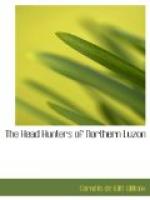Later on Gallman, who speaks Ifugao like a native, interpreted for us. The speaker told his people that a great honor had been done them by this visit of the “Commission,” and that, besides, the great apo [22] of all had come, too. His arrival could not fail to be of good luck for them, as it meant more rice, more chickens, more pigs, more babies, more good in all ways than they ever had had before. As other speeches began to threaten, on a hasty intimation from Mr. Forbes we moved on to our quarters, preceded by the escort of Constabulary.
This detachment, composed entirely of Ifugaos, would have delighted any soldier. They certainly excited my admiration by the precision of their movements, their set-up, and their general appearance. A Prussian Guardsman could not have been more erect. There are five companies of Constabulary in the Mountain Province, each serving in the part of the country from which recruited, and each retaining in its uniform the colors and such other native features as could be turned to account. Thus the only “civilized,” so to say, elements are the forage cap and khaki jacket worn directly over the skin; otherwise the legs, feet, and body are bare; the local gee-string is worn, with the free end hanging down in front. Here at Kiangan each man has below the knee the native brass leglet, and on the left hip the bultong, or native bag, a sporran, indeed, showing the local influence in its blue and white stripes. Thus accoutered, the first impression formed was that these troops were actually highlanders; on reflection, this impression is correct, for they are highlanders in every sense of the word. I obtained permission to inspect the detachment after the honors were over, and found their equipment and uniforms in admirable condition. Of their discipline, everyone spoke in the highest terms; indeed, we had next day, as will soon appear, an example of this quality. Their loyalty to the Government is unquestioned. These mountaineers are all, as might be expected, hardy, strong, able-bodied, and active; in fact, the physical qualities of these mountain people are remarkable. But at Kiangan, as elsewhere, it was noticeable that discipline, regular habits, regular food, had improved the naturally good physical qualities of the people. The Constabulary appeared to me to be physically better than the tribe from which they were drawn. I noticed, too, that after protracted wearing of the khaki the skin of the body was several shades lighter than that of the legs.
We now entered our quarters, being those of Lieutenant Meimban, the native officer in command. Here, too, we met Mr. Barton, the local school superintendent. His predecessor had had to be relieved, because one day, as he was going up the trail, an Ifugao threw a spear “into” him, as they say in the mountains, and he consequently got a sort of distaste for the place, although it was clearly established in the investigation that followed, and carefully explained




